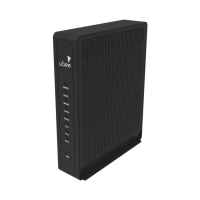
Do you have a question about the Ubee UBC1329AA00 and is the answer not in the manual?
| Device Type | Gateway |
|---|---|
| Ethernet Ports | 4 |
| Frequency Bands | 2.4 GHz |
| Maximum Wi-Fi Speed | 300 Mbps |
| Dimensions | 6.3 x 1.9 x 7.9 inches |
| Weight | 1.1 lbs |
| Downstream Channels | 8 |
| Upstream Channels | 4 |
| WiFi | Yes |
| Telephony Ports | 2 |
| USB Ports | 1 |
| Ethernet Ports Speed | 10/100/1000 Mbps |
| USB Ports Version | 2.0 |
| DOCSIS Standard | DOCSIS 3.0 |
| Wi-Fi Standard | 802.11n |
| Ethernet Ports Type | RJ-45 |
| Wireless Standards | 802.11n |
| Maximum Data Rate | 343 Mbps |
| Security Features | WPA, WPA2, WEP |
Covers safety, environmental, and regulatory compliance for the device.
Provides safety guidelines for installing and maintaining the UBC1329AA00.
Lists the eco-environmental statements applicable to the UBC1329AA00.
Details the regulatory statements applicable to the UBC1329AA00.
Illustrates the general connection topology and applications of the UBC1329AA00.
Lists the items included in the package for the UBC1329AA00.
Shows images and descriptions of the UBC1329AA00 front and rear panels.
Describes all the physical connection ports on the rear panel of the UBC1329AA00.
Summarizes the behavior and meaning of the device's LED indicators.
Lists the technical features and compliance standards of the UBC1329AA00.
Details the default network settings and login credentials for the device.
Provides an example and description of the device's identification label.
Provides step-by-step instructions for initial device setup and connection.
Explains how to mount the UBC1329AA00 securely on a wall.
Guides on connecting various devices like PCs, phones, and wireless clients.
Instructions for connecting wired devices via Ethernet ports.
Steps to connect analog telephones for voice service.
Steps to connect wireless clients like laptops and smartphones.
Offers tips and solutions for common installation issues.
How to access the web interface from a browser.
Procedure for safely exiting the web user interface.
Guide for modifying the login password for enhanced security.
Details the automatic logout feature for security.
Provides an overview of network status and connected devices.
Manages local and WAN IP network and Wi-Fi connection settings.
Displays current information on network connections and status.
Configures local network settings, including IP addressing and DHCP.
Manages and configures wireless network settings for the device.
Customizes the 2.4GHz wireless network name (SSID) and password.
Customizes the 5GHz wireless network name (SSID) and password.
Connects wireless devices using the Wi-Fi Protected Setup (WPS) method.
Manages the voice (telephony) function status and settings.
Configures Multimedia over Coax Alliance (MoCA) settings.
Secures the network by configuring firewall rules for IPv4 and IPv6.
Provides information about the device's hardware components.
Lists devices currently connected or recently connected to the network.
Allows modification of IP address assignment for connected devices.
Assigns a static IP address to a specific device.
Configure access policies for websites, keywords, and trusted computers.
Control access to specific applications and network services.
Define access rules for specific devices on the network.
Generate and view reports on parental control usage and activity.
Map external ports to internal IP addresses for specific applications.
Dynamically open ports based on network traffic for specific applications.
Place a device in a Demilitarized Zone for open internet access.
Enable UPnP for automatic discovery and port opening for network devices.
Guide to changing the user interface login password.
Explains the impact of signal strength on wireless performance.
Guidance on placement based on signal attenuation through materials.
Comparison of 2.4GHz and 5GHz bands for optimal wireless connectivity.
Advice on choosing the best wireless channel for performance.
